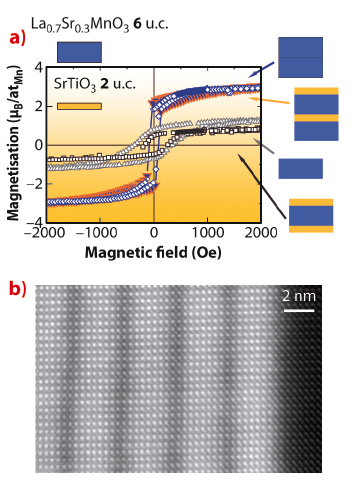- Home
- Users & Science
- Scientific Documentation
- ESRF Highlights
- ESRF Highlights 2011
- Electronic structure and magnetism
- Spin reconstruction at La0.7Sr0.3MnO3/SrTiO3 interfaces
Spin reconstruction at La0.7Sr0.3MnO3/SrTiO3 interfaces
The appearance of emergent phenomena, resulting from the orbital and electronic reconstruction at the lattice discontinuity at complex oxide interfaces, is gathering much research interest. Since spin ordering is largely determined by the orbital structure in these correlated oxides with quenched orbital magnetism, the modified bonding at the interface may determine its magnetic ground state. In experiments at beamline ID08 using X-ray magnetic circular dichroism (XMCD) we have examined the magnetic structure of La0.7Sr0.3MnO3 (LSMO)/SrTiO3 (STO) epitaxial interfaces in the light of its modified orbital structure. We found a magnetic moment induced at the Ti, resulting from the orbital reconstruction, which couples magnetically to the LSMO layers when the STO layer is thin enough. This finding constitutes direct evidence on how macroscopic properties of a heterostructure may be controlled by the interface orbital and spin reconstruction.
 |
|
Fig. 85: a) VSM Hysteresis loops measured at T = 10K of a thin film of 6 u.c. (grey triangles), 12 u.c. (blue diamonds), a thin film of 6 u.c. with a buffer and a capping layer of 2 u.c. STO (black squares) and a heterostructure formed by two LSMO 6 u.c./ STO 2 u.c. bilayers (inverted triangles). Schematics of the “building blocks” used to make the samples to illustrate magnetic coupling. b) High magnification Z-contrast image of a [LSMO6/STO2]8 superlattice from a VG Microscope HB501UX. |
Using a high-pressure pure oxygen sputtering technique, we have grown [LSMOM/STON]8 superlattices consisting of 8 bilayers of M = 2, 6, 14 LSMO unit cells (u.c.) and N STO u.c. (with NSTO = 0, 1, 2, 5, 6, 12, 18, 24), on (100) STO substrates. STEM imaging displayed in the bottom panel of Figure 85 provides evidence of sharp interfaces. Atomic column resolution EELS shows the presence of Ti 3+ at the interface plane indicating a charge transfer mechanism as previously found in LMO/STO interfaces [1]. Multilayers with thick STO (N > 6) behave magnetically as the superposition of isolated LSMO layers showing reduced values of the saturation magnetisation and Curie temperature MS = 1.5 µB/atMn and TC = 150 K characteristic of the presence of dead layers. Whereas, heterostructures with thin STO spacers showed MS = 3.2 µB/atMn and TC = 280 K indicating that substantial magnetic coupling may exist between the layers (see top panel of Figure 85). This is a striking result in view of the insulating and non-magnetic nature of the STO and suggests that a significant interface reconstruction may be taking place. XMCD spectra showed clear Ti dichroic signals (see Figure 86) which closely tracked the Mn signal when temperature was varied evidencing that Ti moment originates at the Mn-O-Ti superexchange interaction at the interface. The negative value of the Ti moment indicates that its direction is opposite to the magnetic field, and hence that the Mn-Ti coupling is antiferromagnetic.
 |
|
Fig. 86: XMCD spectra at the a) Mn and b) Ti L edge of [LSMOM/STO2]8 at 6 K in a 1 T magnetic field. c) Temperature dependence of Ti and Mn dichroic signals. d) Sketch illustrating the possible magnetic coupling through thin STO layers mediated by the interfacial Ti moments. |
As a result of the lattice mismatch between STO and LSMO and the reduced electron density in LSMO compared with undoped LaMnO3, the hybridised “down” dxz,yz bonding orbitals reside lower in energy than hybridised “up” bonding d3z2-r2 orbital. Because of charge transfer Ti is in a mixed 3+/4+ oxidation state at the interface, resulting in the antiferromagnetic coupling with Mn.
These electrons residing in dxz,yz orbitals at the interface provide a mechanism for the magnetic coupling of the manganite layers if the STO layer is thin enough. The effect of coupling is to order the interface spins and hence to increase the saturation magnetisation and Curie temperature and to reduce the low temperature magnetoresistance. The physical mechanism of the coupling could be through direct exchange by free carriers of the STO spreading into 1-2 unit cells, suggesting that in fact the interfacial STO layer might be in a metallic ground state, consistent with the observed presence of Ti3+ at the interface.
In summary we have found a magnetic coupling between LSMO layers through (nominally insulating and diamagnetic) STO spacers driven by an induced magnetic moment at the Ti atoms resulting from the Mn-O-Ti superexchange interaction at the interface. This provides the channel for the magnetic interaction between LSMO layers when the STO is thinner than 1 nm resulting in the magnetic coupling of the manganite layers and a suppression of the magnetic dead layer.
Principal publication and authors
F.Y. Bruno (a), J. Garcia-Barriocanal (a,b), M. Varela (c), N.M. Nemes (d), P. Thakur (e), J.C. Cezar (e), N.B. Brookes (e), A. Rivera-Calzada (a), M. Garcia-Hernandez (d), C. Leon (a), S. Okamoto (c), S.J. Pennycook (c) and J. Santamaria (a). Phys. Rev. Lett. 106, 147205 (2011).
(a) GFMC. Dpto. Física Aplicada III, Universidad Complutense de Madrid (Spain)
(b) SpLine Spanish CRG Beamline at the ESRF, Grenoble (France)
(c) Materials Science and Technology Division, Oak Ridge National Laboratory, Oak Ridge (USA)
(d) Instituto de Ciencia de Materiales de Madrid ICMM- CSIC, Madrid (Spain)
(e) ESRF
References
[1] J. Garcia-Barriocanal et al., Nature Comm. 1, 82 (2010).



